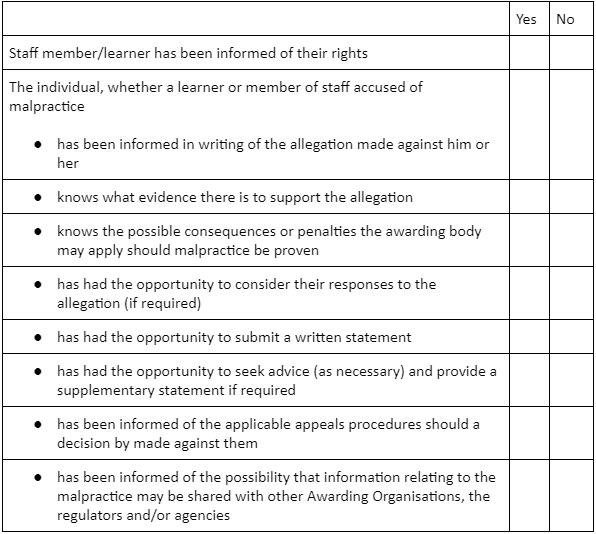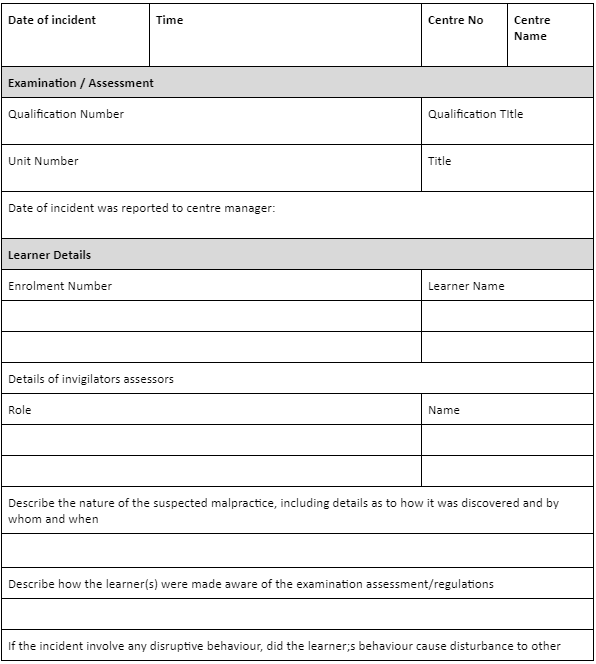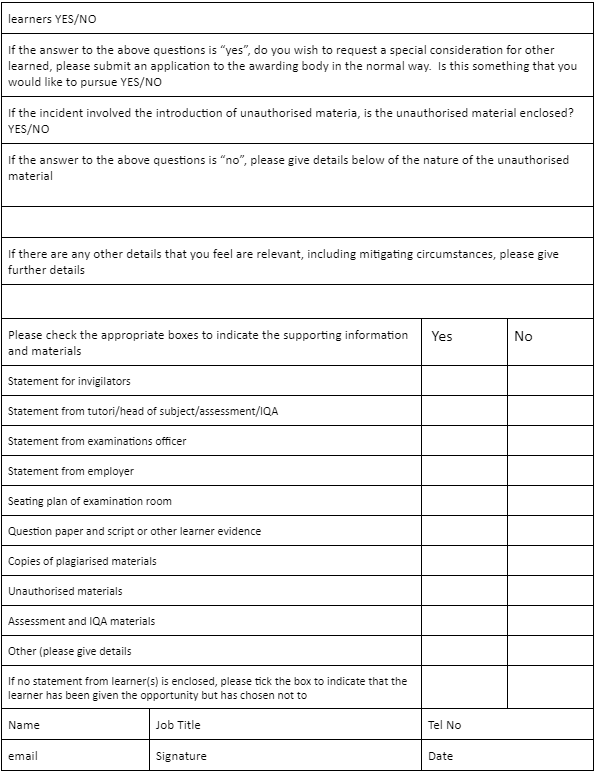Malpractice and Maladministration Policy and Procedure
Malpractice is defined as an act of an instance of improper practice and includes maladministration. Malpractice is any activity, practice or omission which is either willful, negligent or deliberately contravenes relation and compromises
- • The internal or external process
- • Integrity of a regulated qualification
- • Validity of a result or certificate
- • Reputation and credibility of an awarding body
Maladministration is defined as any activity, or mission which results in centre or learner non-compliance with administrative relations and requirements.
Any areas of malpractice and maladministration will be taken seriously and investigated. Disciplinary procedures may be involved if investigations produce evidence and just cause.
Centre malpractice
Although this is not an exhaustive list, include:
• Inadequate centre/provider procedures for the induction of members of staff
• Failure to provide learners and members of staff with the knowledge of their responsibilities through relevant policies and procedures that include the
possible consequences of non-compliance
• Failure to review systems, policies and procedures so that they remain fit for purpose
• Inadequate support for learners and members of staff that includes ways of helping learner understand how malpractice can occur and be prevented
• Failure to follow procedures relating to malpractice, maladministration and/or plagiarism.
• Failure to have robust procedures in place for the review and monitoring of any administrative, assessment or quality process/activity that could result in deliberate falsification of records.
• Failure to maintain accurate records relating to learners, assessment or internal quality assurance or to retain such records for a required period of time.
PLAGIARISM
INTRODUCTION
Plagiarism (defined by the Association of Colleges as “the presentation of someone else’s work, ideas, opinions, or discoveries, whether published or not, as one’s own) is considered unacceptable as authentic evidence for assessment.
In order for accurate assessment of a learner’s knowledge and understanding to occur, it is essential that information presented is created and compiled by the learner themselves.
Where referencing or quotation is used from a secondary data source within a written assessment, it should meet the following criteria:
• Quotation marks/referencing marks should be used and credited to the original source
• The information should be used as an example or illustration of a point made/concept expressed in the text
• The information should be only of a length necessary to provide the relevant illustration or example
• The quotation or reference should provide an opportunity for the learner to demonstrate understanding, through the ability to select relevant secondary data for the illustration or example
The copying of a fellow learner’s work is equally unacceptable as assessment evidence.
Where plagiarism in these circumstances is clear i.e. word for word, or with one or two words/phrases/the formatting changed, the work will be voided for assessment, and an alternative opportunity for re-assessment provided, which matches the particular learning outcome assessment policy and guidelines.
Any work deemed to have been copied, either from material published in the public domain, or fellow learners will not be accepted and such incidents will be referred to the Assessment Panel for investigation.
Centre influencing the assessment or certification process
This is not an exhaustive list but would include:
• Failure of a member of the staff to report any instances of malpractice or suspected malpractice to their line manager
• The unauthorised obtaining, dissemination or facilitating of access to assessment materials
• Permitting, facilitating, obtaining or disseminating unauthorised access to secure assessment materials
• Assisting or promoting learners in the production of answers to assessment
• any action or inaction that allows learners to have an unfair advantage
• Falsification or fabrication of learners’ marks, assessment evidence, observation records, certification claims or results documentation and any other record regarding an Awarding Body result
Centre malpractice - conduct of examinations
This list is not exhaustive but would include:
• Members of centre staff undertaking any examination on behalf of learner(s)
• Breaches of any secure materials
• Changes that are unauthorized to examination timetable
• Failure to issue learners with appropriate notices and warnings
• Not adhering to invigilation requirements
• Failure to dispatch examination materials in a timely manner
• Amendment of examination materials without permission
• Failure to provide access arrangements where required.
Green Labyrinth Learners
This list is not exhaustive but would include
• Falsification or fabrication of examination/assessment evidence
• Any form of impersonation
• Obtaining or attempting to obtain secure examination/assessment materials
• Offering a bribe or any kid to an invigilator, a member of centre staff
• Any form of plagiarism
• False declaration of authenticity in relation to the contents of any assessment produced by the learner
• Any form of cheating to gain an improper advantage
• Collusion ie allowing another learner to copy work
• Use of unauthorised material or instruments into the examination room/assessment session
• Misuse or attempted misuse of examination material
• Exchanging, obtaining or receiving unauthorized or confidential material
• Disruptive, violent or offensive behaviour
• Any form of communication with other learners (written, verbal, gestures, expressions ) during exam conditions
• Failure to abide by the instructions set by the invigilator
Any other persons
• Forgery of certificates
• Threats or inducements to any person involved in the assessment process intended to influence the outcomes of assessment.
Centre Maladministration
Examples of Centre maladministration include:
• Persistent mistakes or poor administration with a centre resulting in the failure to keep appropriate learner assessment records
• Inaccurate recording of learner assessment decisions leading to invalid claims for certification
• Non-compliance of awarding body requirements (from Centre handbooks or similar documentation)
• Failure to retain accurate records of learner assessment decisions for the specified timescales
• Failure to keep question papers secure prior to and after examinations
Process and procedures to implement in any investigation of suspected malpractice
Malpractice may be detected in a number of ways, including:
• Identification by a centre tutor, assessor or internal verifier or other member of staff
• Verbal or written allegations that are reported openly or anonymously by a learner, third party or other interested party to a centre/provider.
All suspected or alleged cases of malpractice or maladministration must be reported to the appropriate awarding body within 48 hours of it being identified and prior to the commencement of an internal investigation.
Appropriate forms for each awarding body should be completed and returned to the awarding body in the first instance. An example of the process to follow is in Annex A if specific awarding body requirements are NOT requested.
Actions following an investigation
In most investigations into suspected malpractice, decisions will be made by external awarding body staff. Please refer to individual awarding body requirements.
Learner malpractice/maladministration
Learner malpractice/maladministration will result in:
• A written warning issued and, if the offence is repeated, further specified sanctions may be applied
• Not allowing all or part of the learner(s) assessment evidence or marks
• The learner(s) certificate will not be issued
• No further registrations will be accepted for the learner(s)
• Barring the learner(s) from entering any examinations for a set period of time
Centre malpractice/maladministration
Different awarding bodies will implement different actions. The following is an example of what might occur:
• Implementation of an agreed improvement action plan
• A written warning may be issued that if the offence is repeated or a similar offence occurs in the future, further specified sanctions may be applied
• The centre risk rating may be reviewed
• Increased centre visits my be implemented and the introduction of sanctions
• Removal of direct claim status
• Suspension of centre approval or qualification approval
• Withdrawal of centre approval for a set period of time or indefinitely
• Staff training on specific items or mentoring with a period of time with a review at the end of the process
• Appointment of independent invigilators to observe an examination which may incur a cost to the centre
There will be an appeal procedure for the centre to follow which my need to be investigated in order to follow particular awarding body requirements.
Requirements of reporting malpractice
Check with the Awarding body what the particular process is to cover the report of malpractice. Most awarding bodies will have a specific form which will include:
• A detailed account of the circumstances surrounding the malpractice
• The procedures for advising learners and/or centre staff of the regulations concerning the conduct of examinations and/or assessments
• The procedures for advising learners of the plagiarism policy and guidance on submitting evidence
• Signed and dated statements from staff concerned on GL’s headed paper
• Seating plan of exam rooms (where applicable)
• Copies of plagiarised materials (where applicable)
• Unauthorised material removed from the learner
• Full name and contact details of the Head of Centre
ANNEX A
Malpractice notification form checklist
What is this checklist for?
This checklist is intended to assist staff when completing a notification of suspected malpractice by staff or students.
Please indicate by ticking the appropriate box for the following points:


Annex B
Malpractice and Maladministration - Notification Form
Confidential
Centres must use the form below to notify the Awarding Body of suspected malpractice and/or maladministration involving centre staff



